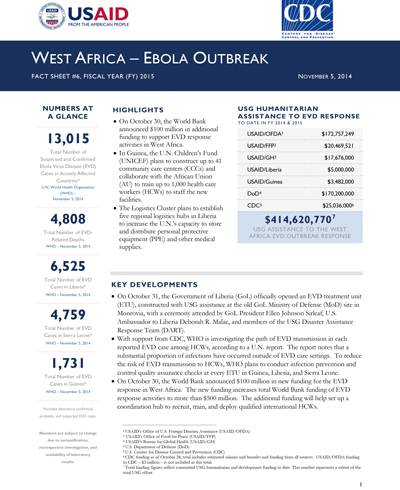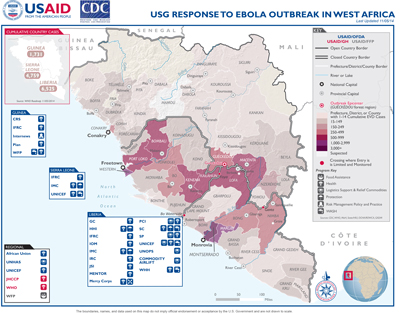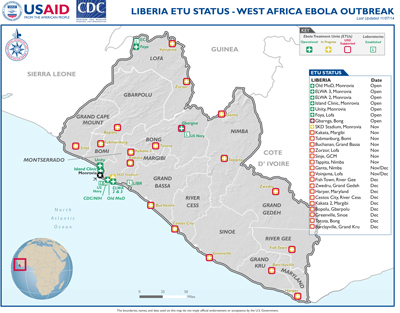Speeches Shim
November 5, 2014
HIGHLIGHTS
Ebola Response
Visit our main West Africa Ebola Outbreak page to learn more about how we're responding to the West Africa Ebola outbreak, and what you can do to help.
- On October 30, the World Bank announced $100 million in additional funding to support EVD response activities in West Africa.
- In Guinea, the U.N. Children’s Fund (UNICEF) plans to construct up to 41 community care centers (CCCs) and collaborate with the African Union (AU) to train up to 1,000 health care workers (HCWs) to staff the new facilities.
- The Logistics Cluster plans to establish five regional logistics hubs in Liberia to increase the U.N.’s capacity to store and distribute personal protective equipment (PPE) and other medical supplies.
West Africa - Ebola Outbreak - Fact Sheet #6 (FY 15) ![]() (pdf - 281k)
(pdf - 281k)
KEY DEVELOPMENTS
- On October 31, the Government of Liberia (GoL) officially opened an EVD treatment unit (ETU), constructed with USG assistance at the old GoL Ministry of Defense (MoD) site in Monrovia, with a ceremony attended by GoL President Ellen Johnson Sirleaf, U.S. Ambassador to Liberia Deborah R. Malac, and members of the USG Disaster Assistance Response Team (DART).
- With support from CDC, WHO is investigating the path of EVD transmission in each reported EVD case among HCWs, according to a U.N. report. The report notes that a substantial proportion of infections have occurred outside of EVD care settings. To reduce the risk of EVD transmission to HCWs, WHO plans to conduct infection prevention and control quality assurance checks at every ETU in Guinea, Liberia, and Sierra Leone.
- On October 30, the World Bank announced $100 million in new funding for the EVD response in West Africa. The new funding increases total World Bank funding of EVD response activities to more than $500 million. The additional funding will help set up a coordination hub to recruit, train, and deploy qualified international HCWs.
CURRENT SITUATION
Speaking in Monrovia, Liberia, on November 4, U.N. Special Representative of the Secretary-General (SRSG) and Head of the U.N. Mission for Ebola Emergency Response (UNMEER) Anthony Banbury noted that communities, supported by national and local governments with the backing of international partners, must continue engaging on the central elements of EVD response efforts, including ETUs, safe burials, contact identification and tracing, and community mobilization. SRSG Banbury and WHO Assistant-Director-General Dr. Bruce Aylward cautioned that drawing conclusions from recent EVD outbreak trends is premature, highlighting that global efforts still need to scale up. The USG, in coordination with other governments, U.N. agencies, and EVD response organizations, continues to scale up response efforts in acutely affected countries in West Africa, employing a flexible response strategy to address needs as they emerge.
Liberia
On October 31, the GoL held a ceremony to open an ETU at the old GoL MoD site in Monrovia. GoL officials report that the ETU has an initial capacity of 20 beds, with plans to scale up in the coming weeks, as necessary. USAID provided material support, including plastic sheeting and generators, to the U.N. World Food Program (WFP) for the construction of the ETU, which consists of two modules with a total capacity of 200 beds.
The U.N. is establishing five regional logistics hubs to increase storage and distribution capacity for the delivery of adequate amounts of PPE and other supplies to health facilities—including ETUs and CCCs—throughout Liberia. The U.N. plans to establish the new logistics hubs by the end of November in Bong, Grand Bassa, Grand Gedeh, Lofa, and Maryland counties.
In Bomi, Grand Cape Mount, and River Gee counties, strikes by HCWs in more than half of operational non-EVD health facilities could significantly impair basic health services amid the EVD outbreak, according to the U.N. In addition, the U.N. reports that a shortage of PPE for health care personnel poses a substantial hindrance to the provision of basic care in non-EVD health facilities.
USAID/OFDA is supporting John Snow International (JSI) Research and Training Institute with $3.1 million for infection prevention and control training in Liberia to reduce EVD transmission rates in non-EVD care settings. The training will provide practical, experiential learning opportunities for health care providers and support staff at non- ETU health care facilities, as well as increase the availability of PPE and supplies through supply chain distribution and management. JSI will implement Phase I of the program in Liberia’s most-affected counties, including Bomi, Bong, Grand Bassa, Grand Cape Mount, Lofa, Margibi, Montserrado, and Nimba.
On October 30, DART members, CDC technical advisors, and representatives from the GoL and non-governmental organization (NGO) eHealth Africa, visited Bomi to assess a proposed county-level emergency operations center (EOC) site. The county-level EOC in Bomi will likely be operational by the end of November and will be the first of five county-level EOCs planned for Liberia’s priority counties—Bomi, Bong, Margibi, Montserrado, and Nimba. The EOCs will strengthen coordination of response activities, including implementation of prevention measures, dispatch of burial teams, and coordination of EVD care.
CDC’s Division of Global Migration and Quarantine (DGMQ) is working with the GoL to detect travelers with EVD symptoms at ports of entry in Liberia, including airports, seaports, and land border crossings. In collaboration with CDC, officials at Liberia's Roberts International Airport (RIA) are implementing DGMQ protocols for two-stage exit screenings of airline travelers departing Liberia. A team of nurses uses a screening questionnaire, visual assessment of travelers, and non-contact infrared thermometers to check travelers for EVD symptoms, and assess potential EVD exposure. Since August, health authorities at RIA have screened more than 11,000 departing passengers. In the coming weeks, Liberia’s Spriggs Payne Airport will initiate a similar exit screening process.
USAID/OFDA is providing nearly $7.4 million to NGO Heart to Heart International (HHI) for EVD response activities in Liberia. HHI plans to clinically manage an ETU with up to 50 beds in Nimba County. USAID/OFDA funding will also support psychosocial support services at the ETU.
USAID/OFDA is providing additional support to UNICEF to safely handle, collect, and transport medical waste at four ETUs in Margibi and Montserrado counties. With USAID/OFDA funding, UNICEF is also supporting water, sanitation, and hygiene (WASH) needs at up to 65 CCCs in Liberia.
Sierra Leone
On November 1, U.S. Ambassador to Sierra Leone John F. Hoover, Deputy Chief of Mission Kathleen FitzGibbon, Medical Director of Department of State Medical Services Dr. Gary Penner and DART staff visited the International Medical Corps (IMC) ETU site under construction in Lunsar town, Port Loko District, where EVD cases have been increasing. IMC expects the ETU to open by November 20 with 10 beds and plans to expand the ETU to 50 beds, if needed.
The U.K. Department for International Development (DFID) is providing three new laboratories and associated staff in Sierra Leone, the first of which began testing suspected EVD specimens in Kerry Town the week of October 27. The laboratory in Kerry Town doubles Sierra Leone’s testing capacity. Currently, testing EVD samples can take up to five days to complete, but health authorities expect testing times to decrease to as little as one day, once the laboratories are fully operational.
On November 2, SRSG Anthony Banbury visited Port Loko where, in response to the increased EVD caseload, DFID is supporting the construction of a 100-bed ETU. In partnership with DFID, the Government of Australia announced $20 million in funding to support construction and staffing of the ETU. NGO GOAL will manage ETU operations and staff.
As part of social mobilization efforts, CDC and in-country partners are rolling out an “Ebola Big Idea of the Week” campaign in Sierra Leone, which will emphasize key EVD issues to public audiences. The messages will reach people through radio and television broadcasts, house-to-house campaigns, printed media, text messaging, social media, and discussion forums. The first message for the week of November 10 is “Safe Burials Save Lives.” Subsequent messages include “Stay Safe While You Wait,” and “Celebrate Survivors.”
USAID/OFDA and DFID are supporting training and logistics for safe burial teams throughout Sierra Leone based on CDC-developed infection control protocols. CDC communication staff will continue working with Government of Sierra Leone partners to develop supporting materials and communication messages to raise awareness of, and promote adherence to, safe burial procedures.
Guinea
A Government of Guinea (GoG)-led EVD operational plan workshop, which concluded on October 29, resulted in progress on GoG EVD planning efforts—including significant contributions to support the EVD response in Guinea by the U.N. and other donors. During the workshop, UNICEF committed to building and equipping 41 CCCs in eight prefectures, including two each in Mamou and Nzérékoré prefectures; five each in Forécariah and Yamou prefectures; six each in Faranah, Lola, Macenta prefectures; and eight in Guéckédou Prefecture . In addition, UNICEF—in collaboration with the AU—is training more than 1,000 HCWs from the Democratic Republic of the Congo to staff EVD ETUs and CCCs in Guinea.
In Macenta Prefecture, humanitarian agencies report that the EVD situation continues to deteriorate. Following visits to two villages in Macenta, a local NGO reports that the affected villages are highly skeptical of EVD interventions. According to the U.N., relief organizations report the increase in EVD cases and EVD-related deaths in Macenta may be attributed to insufficient social mobilization efforts, poor public awareness of EVD, and significant delays in paying community mobilizers. However, CDC reports progress in accessing intervention resistant areas such as those in Macenta. CDC continues to actively implement innovative methods to reach resistant communities with EVD-related awareness messages.
In response, USAID/OFDA is supporting community mobilization efforts in Guinea through the IFRC and Plan International, including through radio and television broadcasts, house-to-hopuse health promotion campaigns, and training volunteers on community-based awareness. IFRC estimates that social mobilization activities in Guinea have reached an estimated 936,000 beneficiaries in Guinea since April 2014.
WFP plans to build at least four ETUs across Guinea, with planned sites in Beyla, Coyah, Kéraouné, and Nzérékoré prefectures; construction of a 100-bed facility in Coyah commenced on October 24. USAID/OFDA is supporting the WFP Special Operations Appeal to construct at least two ETUs in Guinea.
As the number of EVD cases in Coyah and Kéraouné continues to increase, WFP is pre-positioning food supplies and establishing local partnerships for food distribution in the affected villages. In mid-October, WFP distributed 1,230 metric tons (MT) of food aid to approximately 51,000 people in Guéckédou, Macenta, Nzérékoré, and Youmou prefectures.
With funding from USAID/OFDA, Catholic Relief Services (CRS) plans to work with technical experts to train health care staff in infection prevention and control techniques and monitor and evaluate infection control activities at targeted sites, while providing assistance to the GoG Ministry of Health to build infection control capacity. In support of infection control activities, CRS will provide PPE to approximately 165 non-EVD health care facilities for a period of six months.
Mali
On October 25, Mali’s first EVD case, a traveler from Guinea, died with no confirmed transmission of EVD to potential contacts. In response to Mali’s first EVD case, the Government of Mali (GoM), with support from WHO and other partners, has placed approximately 40 people who had direct contact with the case under observation. To date, health authorities have identified 108 potential contacts. Mali is now the sixth West African nation to document confirmed cases of EVD.
Health experts from the National Public Health Institute of Quebec, CDC, and USAID participating in an EVD preparedness mission in Mali are supporting the WHO regional office and headquarters to implement Mali’s National Ebola Emergency Plan. In addition, CDC is providing technical assistance and training related to contact tracing, early alert systems, and sample transport for testing in support of the GoM Ministry of Health.
LOGISTICS AND RELIEF COMMODITIES
The CDC Foundation is providing more than 200 ambulances to support safe transport of confirmed and suspected EVD cases to ETUs, to improve transmission prevention and expedite the provision of treatment for individuals with EVD. The first shipment of ambulances to the most-affected countries is expected to arrive in late November, and the second shipment is expected in early December.
WFP has delivered 15,438 MT of food assistance to benefit approximately 1.1 million people in Guinea, Liberia, and Sierra Leone since April 2014. In addition to emergency food relief, WFP has delivered nearly 35,000 cubic meters of medical cargo to support EVD prevention and treatment activities in all the acutely affected countries.
The U.N. Humanitarian Air Service (UNHAS) is operating flights between field locations and Conakry, Guinea; Freetown, Sierra Leone; and Monrovia, Liberia, as well as flight services between locally affected capitals and regional hubs. To date, UNHAS has transported 1,371 passengers and 13 MT of cargo for 44 organizations, including NGOs, U.N. donors agencies, the diplomatic community, and government partners.
FOOD SECURITY AND LIVELIHOODS
Food insecurity forecasts for the most-affected countries vary according to the severity of the outbreak and type of household, according to a November 3 report from the USAID-funded Famine Early Warning System Network (FEWS NET). For households dependent upon markets in areas worst-affected by the outbreak, below-average incomes and market disruptions have caused households to begin relying on negative coping strategies, such as reducing the number of meals and eating less-preferred foods, to meet basic food needs and, consequently, these populations are currently at Stressed—IPC 2—levels of food security.8 Agricultural households are likely to meet the majority of their staple food needs through their own production in the short-term—two-to-six months—and are expected to experience only Minimal—IPC 1—levels of food insecurity.
INTERNATIONAL RESPONSE
On October 3, Japan provided $22 million in emergency assistance to WHO, WFP, UNICEF, and other international organizations responding to the EVD outbreak in West Africa. This is the first tranche of the $40 million in assistance Prime Minister Shinzo Abe announced at the U.N. General Assembly in September. On October 17, Japan also announced plans to dispatch two medical experts to join the WHO mission in West Africa for one month.
On November 3, UNMEER reported that the Government of the People’s Republic of China (GoPRC) recently increased its aid to EVD-affected countries to $123 million. The GoPRC also pledged to increase the number of medical personnel in the region by 200, bringing the total number of Chinese medical personnel to 700.
PUBLIC DONATION INFORMATION
- The most effective way people can assist relief efforts is by making cash contributions to humanitarian organizations that are conducting relief operations. A list of humanitarian organizations that are accepting cash donations for disaster responses around the world can be found at www.interaction.org.
- USAID encourages cash donations because they allow aid professionals to procure the exact items needed (often in the affected region); reduce the burden on scarce resources (such as transportation routes, staff time, and warehouse space); can be transferred very quickly and without transportation costs; support the economy of the disaster-stricken region; and ensure culturally, dietary, and environmentally appropriate assistance.
More information can be found at:
- The Center for International Disaster Information: www.cidi.org or +1.202.821.1999.
- Information on relief activities of the humanitarian community can be found at www.reliefweb.int.
USAID/OFDA bulletins appear on the USAID website at what-we-





Comment
Make a general inquiry or suggest an improvement.